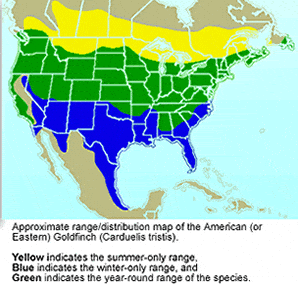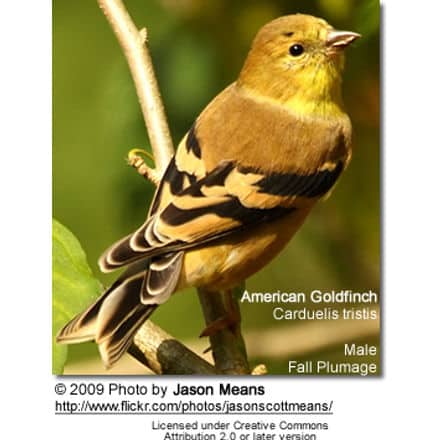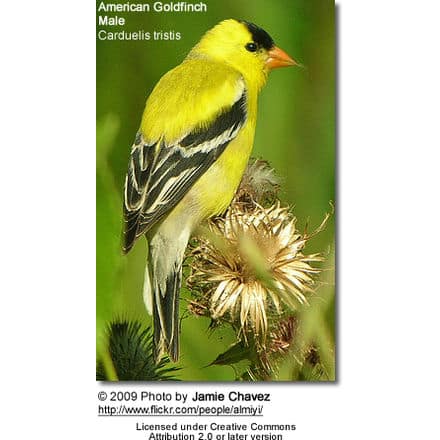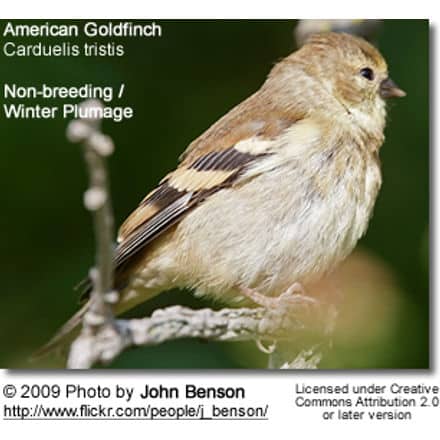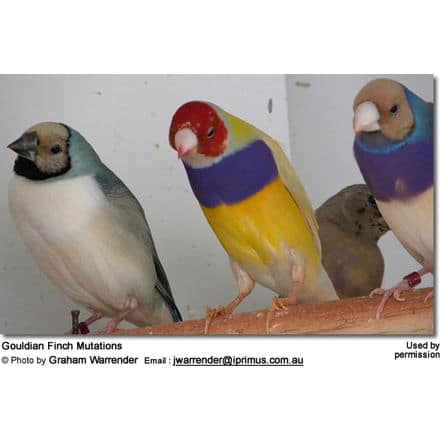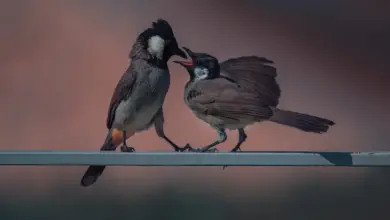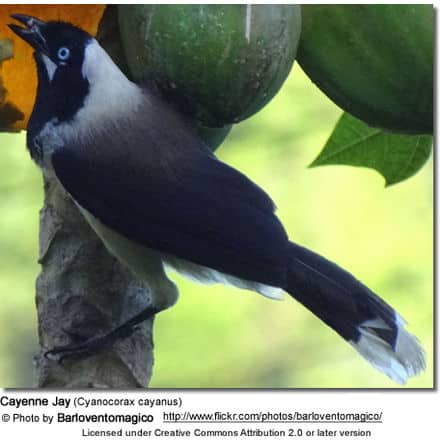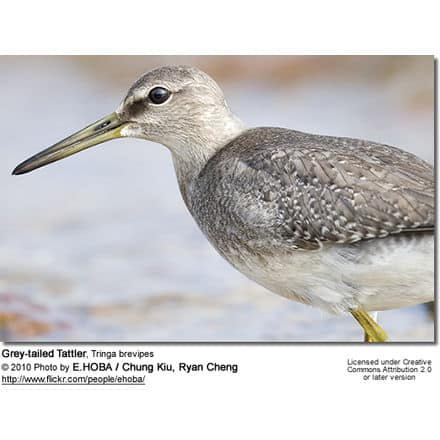American or Eastern Goldfinch
The American Goldfinches (Carduelis tristis) – or simply Goldfinches – are migratory North American finches found across most of North America – from southern Canada through United States into Mexico.
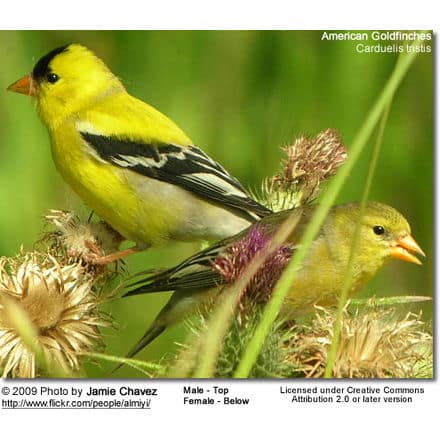
These birds are known by a variety of names – sometimes reflecting their physical attributes, ranges or dietary habitats), such as:
- Wild Canary, Black-winged Yellow Bird, Yellow Goldfinch, Pale Goldfinch
- Lettuce Bird, Thistle Bird
- Northwestern Goldfinch, California Goldfinch, Eastern or Western Goldfinch
The colorful and active Goldfinches are very popular backyard birds, who will readily take advantage of garden bird feeders.
Sometimes they will congratulate in large numbers around feeders. In fact, the easy access to food provided by humans has proven to benefit these birds as these feeders increase their survival rate at those times when natural resources are low. These acrobatic birds are often observed hanging upside down on seed pods.
This finch was named the official State Bird of Iowa, New Jersey and Washington.
Distribution / Habitat
Their natural range stretches from southern Canada (Saskatchewan, Quebec and southwest Newfoundland) south into the United States as far south as North Carolina on the east coast and northern California on the west coast.
Northern populations migrate south for the winter – throughout Florida, along the Gulf Coast east to California and south to Mexico. They migrate in compact flocks.
They are associated with open habitats, such as fields, meadows, flood plains and orchards, but are also quite common in urban gardens, where they are attracted to bird feeders.
Subspecies and Ranges:
There are four recognized subspecies of the American Goldfinch:
- American Goldfinch (Carduelis tristis tristis – Linnaeus, 1758) – the nominate and the most common race
- Summer Range: From southern Canada to Colorado, and east to the Carolinas in the United States.
- Winter Range: South to southern and southeastern United States (northeastern Texas east to northern South Carolina and south to Florida) and eastern and central Mexico.
- Pale American Goldfinch, Pale Goldfinch, Western Goldfinch(Carduelis tristis pallida / pallidus – Mearns, 1890)
- Summer Range: South central British Columbia east to western Ontario in Canada, south to northwestern Colorado and west to Oregon in the United States.
- Winter Range: Extends from southern Canada and northern California, south to north central Mexico (Puebla and Veracruz).
- ID: Body color paler. Bolder white markings. Males have larger black caps.
- Northwestern American Goldfinch(Carduelis tristis jewetti – van Rossem, 1943)
- Range: Occurs on the coastal slope of the Cascade Mountains from southern British Columbia south to southwestern Oregon (west of the Cascades) and to central California, where their range overlaps with that of ssp. pallidus.
- ID: Smaller and darker plumaged.
- Willow Goldfinch (Carduelis tristis salicamans – Grinnell, 1897)
- Summer Range: Southwestern USA – west of the Sierra Nevada range in California.
- Winter Range: South and central Baja California east to the Mohave and Colorado Deserts and south to Mexico (northwestern Baja California).
- ID: Breeding males have smaller black caps than other subspecies. In winter, both genders have browner plumages than other races.
Description
Size / Ranges
- Weight: 0.39 – 0.71 oz (11 to 20 g)
- Length: 4.33 – 5.12 inches (11 – 13 cm)
- Wingspan: 7.5 – 8.7 inches (19 – 22 cm)
Plumage Details / Adults
These finches undergo a molt (change of feathers) in the spring – when they attain their breeding plumage – and in autumn, when they molt into their winter plumage.
Breeding Males (summer and spring plumage):
- Bright yellow plumage, except for …
- Glossy black forehead
- Glossy black wings with white markings
- White patches both above and beneath the tail
Breeding Females:
- Upper plumage olive-brown
- Plumage below is pale olive-yellow
- Wings a dull brownish-black
Winter Adults:
- Plumage a dull, unstreaked brown
- Wings blackish with two pale wingbars
Other Physical Details
- Small finch
- Short, cone-shaped bill that is flesh-colored most of the year, but turns bright orange at the beginning of the breeding season (in both adults)
- Long wings
- Short, notched tail
- Flight path: generally fly while going slightly up and down in a wave-shaped path
Juvenile Description
- Back is dull brown
- Below pale yellow
- Shoulders and tail are dull black with buff-colored markings on wings and rump (white in adults)
 Similar Species
Similar Species
- Lawrence’s Goldfinches: Yellow wingbars (not white)
- Evening Grosbeaks: Twice as large as a Goldfinch. Large wing patches instead of wingbars. Larger beak.
- Pine Siskins: Brown streaks on back and the chest. Bill slimmer. Yellow markings are restricted to small regions of the wing.
- Female Lesser and Lawrence’s Goldfinches: Dark-tipped tails
- Lesser Goldfinches are yellow under the tail (not white)
- Some warbler species (such as the Yellow Warblers) are yellow-plumaged, but they rarely frequent bird feeders, and have slimmer bills.
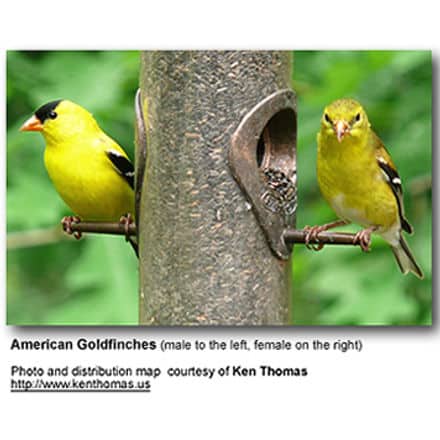
Diet / Feeding
American goldfinches mostly forage on seeds from various plants, including thistle, teasel, dandelion, ragweed, mullein, cosmos, goatsbeard, sunflower and alder.
They will also take grains, nuts, tree buds, maple sap and berries.
They will readily visit bird feeders in backyards – particularly in the winter, when food sources are sparse.
Occasionally, they will also feed on animal foods, such as insects – in particular when raising young as the additional protein is needed to support their rapid growth.
Breeding / Nesting
Breeding season: Most nesting activities occur between late June and September, when their main food source – seeds – are most abundant
Mating system / courtship: These finches are generally seasonally monogamous, although females may mate with more than one mate.
In winter, males will start showing off their colorful physical details (plumage and bill), as well as performing their flight displays to attract prospective females. These entail pursuing the females and the female flying in zigzagging away from the male. Once a male is accepted a female, the pair will fly in wide circles.
Nesting
Nesting occurs in loose colonies that may include two or three pairs – probably to aid in defense against predators.
Once eggs have been laid, the aggressiveness typically fades.
The tightly-woven nest is constructed out of twigs, bark, weeds, vines and grasses, and reinforced with spider webs and caterpillar silk, and lined with soft plant matter. The inside dimensions of an average nest is about 2.5 inches (6.5 cm).
Nests are placed in the branches of trees and shrubs about 3 – 30 feet (~ 100 cm – 10 meters) off the ground.
Clutch Size: 2 to 7 eggs per clutch – the average being 5. The peanut-sized eggs are bluish-white and measure about 6 x .45 inches (16 x 12 mm). In most cases, one clutch is produced in a season. If nests have been lost or the season started early and concluded successfully at a time when temperatures are still within a good range and food supplies are still ample, another clutch (rarely even two) may be produced.
Incubation Period: 12 – 15 days – performed by the female alone, while the male brings food to the nest for the brooding female.
Hatchlings: Blind, naked (except for a little pale-green down) with reddish skin. At this stage, they are completely helpless and weigh on average only 0.04 oz or 1 g.
Nestling Care: Initially the male will be the primary caretaker of the young as the female leaves the nest for extended periods to feed and guard the nesting territory. Although the female will return to the nest to feed the young.
Fledgling: The chicks leave the nest when they are about 11 – 17 days old and are independent when they are about 6 weeks old.
Goldfinch nests may occasionally be victims of brood parasites, particularly Brown-headed Cowbirds, who lay their eggs in the nests of other birds for them to raise. One study determined that about 9% of all Goldfinch nests contained Brown-headed Cowbird eggs. However, the survivability of the Cowbird chicks is low – which is attributed to their different nutritional requirements.
Calls / Vocalizations / Sounds
Contact calls: “tsee-tsi-tsi-tsit” (often given in flight) or “po-ta-to-chip” or “per-chic-o-ree“
Songs: described as musical “rambling”, “warbling” or “twitters.”
Juvenile Call: chick-kee or chick-wee – often used shortly before fledging
Defense Calls: a sweeet call (to rally other goldfinches to the nest); and bearbee to signal to the nestlings to remain quiet and crouch down.
Alternate (Global) Names
Chinese: ?????, ????? … Czech: ?ížek žlutý, Stehlík americký … Danish: Guldsisken … Delaware: Wisawtayas … Finnish: Amerikantikli … French: Chardonneret jaune, Tarin doré, Tarin triste … German: Goldzeisig, Trauerzeisig … Irish: Lasair choille Mheiriceánach … Hungarian: aranycsíz … Italian: Cardellino americano, Lucherino americano, Lucherino dorato … Japanese: ougonhiwa … Lithuanian: Amerikinis dagilis … Dutch: Goudsijs, Treursijs … Norwegian: Gulstillits … Polish: Czy? czarnoczelny, czyz zlotawy, czy? z?otawy …Portuguese: Pintassilgo-americano … Russian: ???????????? ??? … Slovak: Stehlík zlatý … Spanish: Dominico Americano, Dominiquito Canario, Jilguero americano, Jilguero Canario, Jilguero Yanquí … Swedish: Guldsiska … Turkish: Amerika Sakas?
Life Cycle
- Average lifespan in the wild: up to 11 years
- The oldest known Goldfinch was 10 years and 5 months old
- Typical lifespan in the wild: 3 to 6 years
- Males tend to outlive females
Other Web Resources
- European Goldfinch for Goldfinches occurring in Europe
- Endearing story of a personal encounter with an American Goldfinch pair – a grieving male and a recently deceased female as told by Brian Dupuis

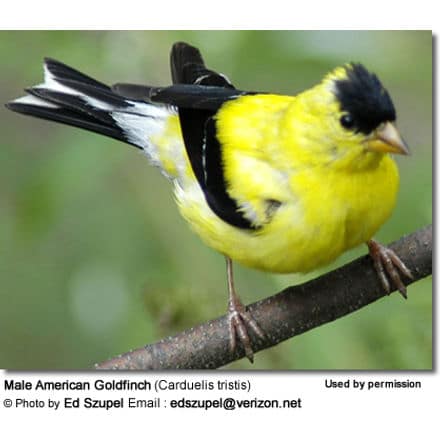
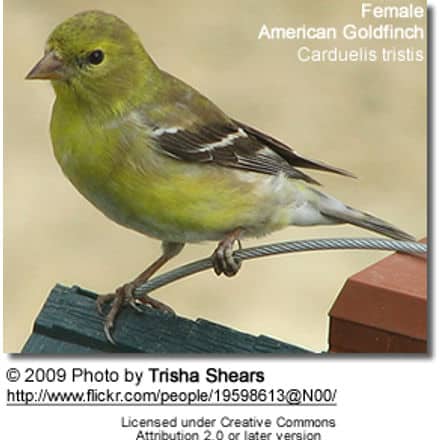
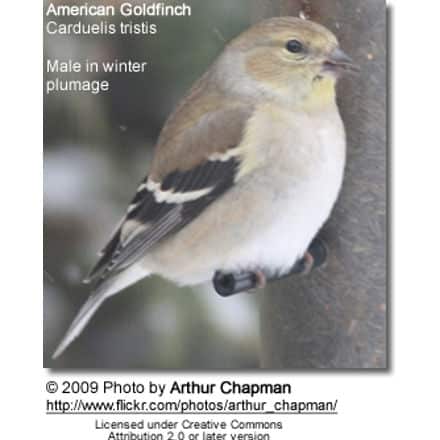 Similar Species
Similar Species